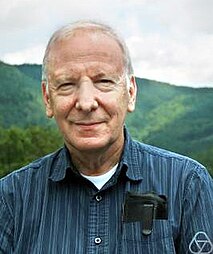Related Research Articles

Physical cosmology is a branch of cosmology concerned with the study of cosmological models. A cosmological model, or simply cosmology, provides a description of the largest-scale structures and dynamics of the universe and allows study of fundamental questions about its origin, structure, evolution, and ultimate fate. Cosmology as a science originated with the Copernican principle, which implies that celestial bodies obey identical physical laws to those on Earth, and Newtonian mechanics, which first allowed those physical laws to be understood. Physical cosmology, as it is now understood, began with the development in 1915 of Albert Einstein's general theory of relativity, followed by major observational discoveries in the 1920s: first, Edwin Hubble discovered that the universe contains a huge number of external galaxies beyond the Milky Way; then, work by Vesto Slipher and others showed that the universe is expanding. These advances made it possible to speculate about the origin of the universe, and allowed the establishment of the Big Bang theory, by Georges Lemaître, as the leading cosmological model. A few researchers still advocate a handful of alternative cosmologies; however, most cosmologists agree that the Big Bang theory best explains the observations.

General relativity, also known as the general theory of relativity, is the geometric theory of gravitation published by Albert Einstein in 1915 and is the current description of gravitation in modern physics. General relativity generalizes special relativity and refines Newton's law of universal gravitation, providing a unified description of gravity as a geometric property of space and time or four-dimensional spacetime. In particular, the curvature of spacetime is directly related to the energy and momentum of whatever matter and radiation are present. The relation is specified by the Einstein field equations, a system of partial differential equations.
In theories of quantum gravity, the graviton is the hypothetical quantum of gravity, an elementary particle that mediates the force of gravity. There is no complete quantum field theory of gravitons due to an outstanding mathematical problem with renormalization in general relativity. In string theory, believed to be a consistent theory of quantum gravity, the graviton is a massless state of a fundamental string.
In general relativity, a naked singularity is a hypothetical gravitational singularity without an event horizon. In a black hole, the singularity is completely enclosed by a boundary known as the event horizon, inside which the gravitational force of the singularity is so strong that light cannot escape. Hence, objects inside the event horizon—including the singularity itself—cannot be directly observed. A naked singularity, by contrast, would be observable from the outside.

Kip Stephen Thorne is an American theoretical physicist known for his contributions in gravitational physics and astrophysics. A longtime friend and colleague of Stephen Hawking and Carl Sagan, he was the Feynman Professor of Theoretical Physics at the California Institute of Technology (Caltech) until 2009 and is one of the world's leading experts on the astrophysical implications of Einstein's general theory of relativity. He continues to do scientific research and scientific consulting, most notably for the Christopher Nolan film Interstellar. Thorne was awarded the 2017 Nobel Prize in Physics along with Rainer Weiss and Barry C. Barish "for decisive contributions to the LIGO detector and the observation of gravitational waves".

The Max Planck Institute for Gravitational Physics is a Max Planck Institute whose research is aimed at investigating Einstein's theory of relativity and beyond: Mathematics, quantum gravity, astrophysical relativity, and gravitational-wave astronomy. The Institute was founded in 1995 and is located in the Potsdam Science Park in Golm, Potsdam and in Hannover where it is closely related to the Leibniz University Hannover. The Potsdam part of the institute is organized in three research departments, while the Hannover part has two departments. Both parts of the institute host a number of independent research groups.
Clifford Martin Will is a Canadian-born theoretical physicist noted for his contributions to general relativity.

Bruce Allen is an American physicist and director of the Max Planck Institute for Gravitational Physics in Hannover Germany and leader of the Einstein@Home project for the LIGO Scientific Collaboration. He is also a physics professor at the University of Wisconsin–Milwaukee.

Robert M. Wald is an American theoretical physicist who studies gravitation. His research interests include general relativity, black holes, and quantum gravity. He is also a science communicator and textbook author.
Ni Wei-tou is a Taiwanese physicist, who graduated from the Department of Physics of National Taiwan University (NTU), and got his PhD of Physics & Mathematics from California Institute of Technology. After his retirement on 1 October 2000, he is now appointed as a professor emeritus of the Department of Physics of National Tsing Hua University (NTHU) at Hsinchu, Taiwan, since 2006.

Alessandra Buonanno is a theoretical physicist. She is a director at the Max Planck Institute for Gravitational Physics in Potsdam, and head of the "Astrophysical and Cosmological Relativity" department. She holds a College Park professorship at the University of Maryland, College Park, and honorary professorships at the Humboldt University in Berlin, and the University of Potsdam. She is a leading member of the LIGO Scientific Collaboration, which observed gravitational waves from a binary black-hole merger in 2015.
Nergis Mavalvala is a Pakistani-American astrophysicist known for her role in the first observation of gravitational waves. She is the Curtis and Kathleen Marble Professor of Astrophysics at the Massachusetts Institute of Technology (MIT), where she is also the Dean of the university's School of Science. She was previously the Associate Head of the university's Department of Physics She was awarded a MacArthur Fellowship in 2010.
Stuart Louis Shapiro is an American theoretical astrophysicist, who works on numerical relativity with applications in astrophysics, specialising in compact objects such as neutron stars and black holes.
Ruth Durrer is a professor of astroparticle physics at the University of Geneva. She works on the cosmic microwave background, brane cosmology and massive gravity.
Peter Shawhan is an American physicist. He is currently professor of physics at the University of Maryland and was a co-recipient of the Breakthrough Prize in Fundamental Physics, the Gruber Prize in Cosmology, and the Bruno Rossi Prize for his work on LIGO.
Norna Robertson is a lead scientist at LIGO at California Institute of Technology, and professor of experimental physics at the University of Glasgow. Her career has focused on experimental research into suspension systems and instrumentation to achieve the detection of gravitational waves.
Jennie Harriet Traschen is an American physicist and cosmologist whose research concerns the structure of the early universe, inflation, black holes and black hole thermodynamics, and quantum gravity. She is a professor of physics at the University of Massachusetts Amherst.
Susan Marjorie Scott is an Australian physicist whose work concerns general relativity, gravitational singularities, and black holes. She is a professor of quantum science at the Australian National University (ANU).
Jocelyn Samantha Read is a Canadian physicist and associate professor of physics at California State University, Fullerton, known for her research on gravitational waves and neutron stars. She is a member of the LIGO Scientific Collaboration, and is an author of research characterizing the gravitational waves caused by neutron star and black hole collisions, and using the measurements of those waves to provide observational verification of the equations of state of neutron stars.
References
- 1 2 3 4 APS Fellows Nominated by DGRAV: 1998, APS Division of Gravitational Physics, retrieved 2020-07-15
- ↑ Doughton, Sandi (May 14, 2018), "Ripples in space-time or 3-pound bird? Ravens at Hanford foul test of Einstein's theory", Seattle Times
- ↑ Beverly Berger at the Mathematics Genealogy Project
- 1 2 "NSF Honors Berger", OU News, Oakland University, p. 2, July 14, 1983, hdl:10323/736
- 1 2 "Community Recognizes Beverly Berger", APS News, American Physical Society, 21 (5), May 2012, retrieved 2020-07-15
- ↑ "Beverly Berger", Humans of LIGO, September 14, 2018. See also "Beverly Berger", LIGO Group, Stanford University, retrieved 2020-07-15
- ↑ Past Executive Committees, APS Division of Gravitational Physics, retrieved 2020-07-15
- ↑ Past Chairs, APS Committee on the Status of Women in Physics, retrieved 2020-07-15
- ↑ GRG Society History, International Society on General Relativity & Gravitation, retrieved 2020-07-15
- ↑ OSU Physics Professor Heidi Schellman chosen as Chair of IUPAP Commission C11, Oregon State University, October 15, 2017, retrieved 2020-07-15
- ↑ Begun, Michael W. (Fall 2015), "Einstein's masterpiece (review of three books including General Relativity and Gravitation)", The New Atlantis, 47: 121–135, JSTOR 43671547
- ↑ Stewart, John M. (March 2016), "Review of General Relativity and Gravitation", Contemporary Physics, 57 (2): 282–283, doi:10.1080/00107514.2016.1156767, S2CID 125017462
- ↑ AAS-IOP Astronomy, IOP Publishing, retrieved 2020-07-15